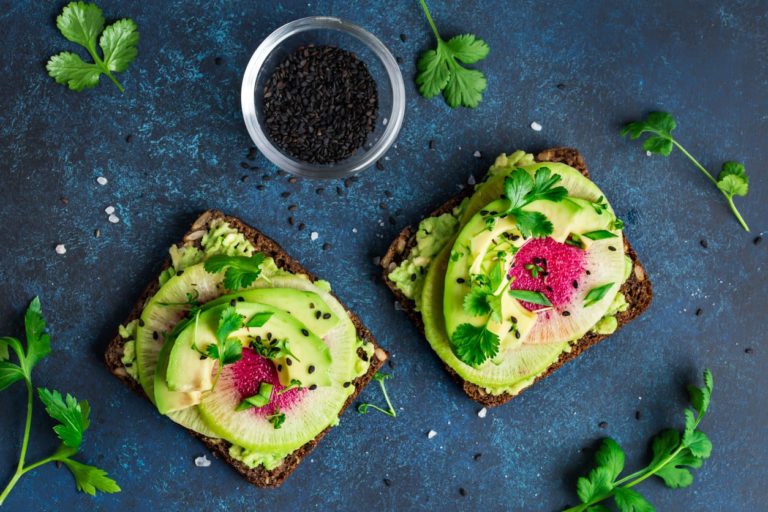We like to think that we’re doing ourselves a favor when we try out one of the many healthy foods that are currently on-trend. From cooking with coconut oil to juicing our own greens, we’ve tried almost everything Instagram health bloggers have enlightened us to.
In actuality, in turns out that some of these “healthy” foods aren’t all they’re cracked up to be.
To shed some light on much-talked about health food crazes, we did some research and consulted functional medicine dietitian, Miriam Jacobson, integrative health coach, Anne Fleming, and Lainey Younkin, registered dietitian at Lainey Younkin Nutrition.
“Health trends can be confusing because they’re not always accurate in terms of what your body needs,” Jacobson said. “I think it’s interesting what comes up, but [it’s] important to take most claims with a grain of salt, as most trends haven’t been studied and tend to be ‘blanket statements.'” Jacobson added,
“I don’t believe in the one size fits all model.”
1. Coconut oil
We use it on our hair, face, nails, and to cook with.
But why is coconut oil so much better than olive oil or other types of oil?
The truth is, it’s not. Jacobson told us that each oil contains a different fat. “Coconut oil is saturated, but if you have a history of heart issues or inflammation olive oil will actually be better,” she said.
Younkin agrees. “Coconut oil is 90% saturated fat,” she added. “It’s definitely okay to use coconut oil in moderation, but on the regular, I recommend olive oil, which is high in monounsaturated fat and a main part of the Mediterranean Diet, one of the healthiest diets in the world. Replacing trans and saturated fats with poly- and monounsaturated fats can lower bad cholesterol and lower your risk of heart disease.”
2. Granola/Trail Mix
Sprinkling a helping of granola onto anything and everything makes a meal feel ~that~ much more healthy.
However, granolas and trail mixes available at the grocery store often contain heaps of added sugar.
Jacobson said, “Pre-made trail mixes do have a ton of sugar (I mean…chocolate, raisins, and peanuts?! I know — I cherry pick those trail mixes, too) but you can make anything healthier.” She suggested creating your own granola mix with pepita seeds, raw almonds, Brazil nuts, coconut flakes, and/or cacao nibs, leaving out the sugary dried fruits and chocolates. “Mulberries or goji berries are such a great addition instead of raisins because they’re sweet but have a lower glycemic response,” Jacobson added.
But if you choose to go for a store-bought version, pick the least-processed granola and/or trail mix you can find, as Fleming suggested. “I do not believe you need to remove [granolas and trail mixes] from the diet altogether unless you have a lot of inflammation going on in the body, but again, use sparingly… and read the labels,” she told us.
3. Veggie Burgers
Although veggie patties and burgers can “certainly be a healthy option,” as Lona Sandon, RD, spokeswoman for the American Dietetic Association (ADA), told Woman’s Day in 2011, “many of the prepared, frozen versions have more fillers (gums, yeast extract and cornstarch), which manufacturers use to achieve a burger-like texture, and less actual vegetables, which are needed to satisfy us nutritionally.”
Check the labels of your frozen pre-prepared veggie patties to ensure they’re made with actual veggies, and that each one contains less than 150 calories, 500 milligrams of sodium, and 7 grams of protein Sandon recommends. Any veggie burger that contains more than 10 grams of protein is most likely made with soy protein and wheat gluten rather than real vegetables.
4. “Heart-Healthy” Whole Wheat
We’ve all seen those Cheerios commercials that promote their whole wheat cereals as being “heart healthy.”
In actuality, whole wheat products are rarely made with actual whole wheat.
According to healthline.com, whole wheat grains are milled finely and can raise blood sugar just as much as refined wheat products. And, for example, most whole wheat breads have similar glycemic indexes as white breads.
Furthermore, the whole wheat we’re consuming today is not the same stuff our ancestors ate centuries, and even mere decades, ago. Modern day wheat has been genetically altered to enhance crop yield, which made the wheat less nutritious and more problematic for those with gluten allergies.
5. Juices
Green juices, detox juices, and smoothies are currently all the rage within the health sphere.
But we may be leaving some serious nutrition behind when we juice fruits and veggies.
“You are not removing the healthiest part but you are removing some nutrients and the all-important fiber,” Fleming told us, in regards to juicing. And Younkin adds, “Juicing will give you a mega-dose of vitamins, minerals, and antioxidants, but that usually comes with a lot of sugar as well, depending on what you’re juicing (fruits have more sugar than vegetables).” Younkin also said that juicing isn’t that much better for you than just eating fruits and vegetables.
And if you’re not juicing organic fruits and vegetables, pesticides could be an issue. Fleming continued, “You want to be juicing organic produce; you are concentrating it down to a small amount and you don’t want to be concentrating the pesticides.”
However, Fleming notes, “The great part about juicing is that you can most likely get as much or more nutrition than eating produce raw, mainly because you can get more plant foods into your body without the bulk.” And if you can’t stand eating your vegetables, juicing can be a saving grace.
6. Veggie Chips
Eat This, Not That claims that veggie chips and potato chips aren’t that far removed.
Some packaged veggie chips from the store contain vegetable powders, which give the chips their colorful look, yet lack nutritional value. And these guys taste so good because of the high amounts of sodium (and sometimes sugar) added to each bag.
Like every other salty snack, eat your veggie chips in moderation. And if you can, swap them out for crunchy raw veggies instead.
7. Agave
Often used as an alternative to sugar, agave nectar can be added to drinks, cereals, smoothies, and more.
It’s more natural than processed white sugar, so therefore it’s better for us, right? Wrong.
According to healthline.com, agave contains massive amounts of fructose — more so than actual sugar. Consuming large amounts of fructose can cause metabolic problems, as proved by a 2009 National Institute of Health study.
Sugar contains about 50% fructose. And agave contains 70% to 90% fructose.
So yes, agave is a natural alternative to sugar, but it’s not an alternative that is actually better for your health. In reality, there’s no “healthy” sweetener, so just make sure you’re using minimal amounts of sugar, agave, stevia, etc.
8. Avocados
Hold on! Don’t freak out just yet — avocados are healthy, but in moderation.
As you’ve probably heard, avocados contain “good fat,” meaning they’re great for your heart. However, they still are high in calories with each one containing about 250, according to Fleming.
“The American Heart Association recommends limiting fat intake to 20% to 35% of total daily calories and keeping saturated fat less than 10% of calories each day,” Younkin told us. “If my clients are adding avocado to a meal, I recommend 1/4 — 1/2 of the avocado, depending on their hunger level and the size of the avocado.”
9. Gluten-Free Snacks
“If you don’t have Celiac disease or a gluten intolerance, you don’t need to eat gluten-free foods,” Younkin told us.
Just because these snacks don’t contain processed wheat, doesn’t necessarily mean they’re healthier for you.
It’s important to look at the ingredients when buying snacks that are gluten-free. As Jacobson told us, most gluten-free foods are made from white rice or potato starch, which aren’t necessarily healthier than whole grains. “However, if the base is quinoa or brown/wild rice, etc., versus a whole wheat cracker, I’d probably go for the [former] regardless of sensitivities/intolerance.”
Opting for gluten-free options when not necessary for your diet, “could drastically cut your fiber intake, and fiber is important for weight management, heart health, and digestion,” Younkin said.
10. Bran Muffins
You think you’re doing yourself a favor when you opt for a bran muffin over that blueberry one, right?
Unfortunately, your “healthy choice” may not be all that healthy. “Depending on the size, a bran muffin can have more calories and sugar than a doughnut,” Joan Salge Blake, RD, LDN, author of Nutrition & You, shared with Women’s Day.
If you’re going for a bran muffin to up your fiber intake, try out a bran cereal instead — just make sure it’s low in sugar. But if you’re getting a muffin because you like muffins, then you might as well go wild.
11. Margarine
These days, margarine seems to be on the outs as people learn more about what it contains.
But just a few years back, margarine was all the rage. It was marketed to be a healthier alternative to butter because it contained less saturated fat.
However, margarine is no saint. It’s filled with refined vegetable oils and is basically just a concoction of chemicals that can actually increase one’s risk of heart disease, according to a Framingham Heart Study.
Just stick to butter. It may contain saturated fat, but at least we know what’s in it.
12. Protein Bars
They may claim to be great for you, but protein bars are actually harboring a lot of sugars and additives. Jacobson told us, “Most protein bars are nuts coated with sugar [and] chocolate and contain so many additives and fillers. They also tend to be very high in sugar and many people rely on them for a healthy option even though often times they’re not.”
She recommends finding other healthy options to rely on that fit within your diet and will help you achieve your goals. Being picky with your health foods is necessary.
13. Organic/All-Natural Candy
As we mentioned about agave — sugar is sugar, and it’s never good for you.
Any candy that is marketed as “organic,” “all-natural,” or “guilt-free,” most likely still contains some form of sugar, be it cane, stevia, agave, etc. As Eat This, Not That writes, even the organic candies have low nutritional content, so you’re better off snacking on some sweet fruit or even some dark chocolate if you’re worried about your sugar intake.
14. Reduced-Fat Peanut Butter
Although “reduced-fat” is a term that usually means a food is generally better for you, reduced-fat peanut butter is actually just the opposite.
“The fat in peanut butter (a combination of polyunsaturated fat and monounsaturated fats) is actually healthy, so there’s no need to take it out,” says Karen Ansel, RD, CDN, spokeswoman for the ADA, told Women’s Day. And when those fats are taken out, they are usually replaced with sugar to keep the peanut butter’s flavor consistent.
The best product you peanut butter fiends should indulge in is all-natural peanut butter that contains just peanuts and salt. But make sure you’re eating peanut butter in moderation. Peanuts are high in fat, so pay attention to how many spoonfuls you’re snacking on.
15. Flavored Yogurt
Yogurt can do some amazing things for your gut health.
No need to take additional probiotics if you’re eating a helping of yogurt everyday. However, you may want to opt out of flavored yogurt and stick to the original stuff. When fruity flavoring is added to regular yogurt, a hefty amount of sugar is also stirred into the mix. As Eat This, Not That reports, some yogurt brands add upwards of 20 grams of sugar per serving of flavored yogurt.
If you need a fruity flavoring, opt for a yogurt brand that has about or less than 8 grams of sugar per serving. Or, add your own flavor by dropping some fruit into your cup.
16. Diet Sodas
Yeah, you knew this one was coming.
Just because it says “Diet” on the can does not mean it’s a healthier alternative to the original soda. It’s true that diet sodas have zero calories, but the artificial sweeteners inside can cause headaches, the caffeine can dehydrate you and your skin (ahem — breakouts much?), and one study even found that diet soda enthusiasts were 30% more likely to be depressed.
There is a slew of bad side effects related to drinking diet soda. Water or tea is sounding a lot more appetizing…
Again, sticking to basics and learning what makes you feel great is key to crafting a healthy diet.








